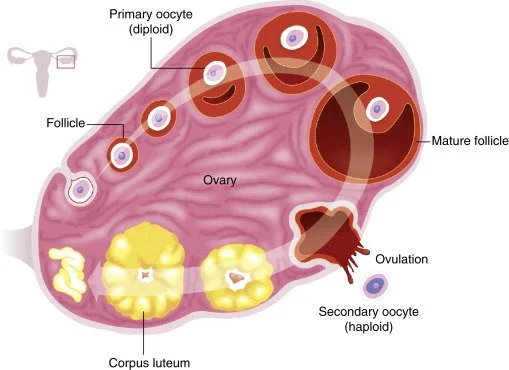Ovulation Trigger Medications: Final Egg Maturation and Ovulation Trigger
Ovulation trigger medications play a crucial role in fertility treatments, particularly for in vitro fertilization (IVF) and other assisted reproductive technologies (ART). These medications induce the final maturation of eggs and trigger ovulation, preparing the body for egg retrieval or timed intercourse. Choosing the right ovulation trigger is essential for optimizing fertility treatment success while minimizing complications such as ovarian hyperstimulation syndrome (OHSS). Brush up on your trigger shot knowledge here or here with The IVF Kitchen!
Human Chorionic Gonadotropin (hCG) Triggers
hCG is a hormone that mimics luteinizing hormone (LH), which naturally triggers ovulation.
Ovidrel (Choriogonadotropin Alfa)
What it does: A recombinant form of hCG that stimulates the final maturation of eggs and triggers ovulation.
How it’s used: A subcutaneous injection given approximately 34-36 hours before egg retrieval or timed intercourse.
Considerations: Ovidrel is a convenient, pre-filled syringe with a lower risk of OHSS than urinary-derived hCG injections.
Pregnyl / Novarel (hCG Injections)
What they do: Urinary-derived hCG injections that function similarly to Ovidrel by triggering ovulation.
How they’re used: Intramuscular injections, administered about 34-36 hours before ovulation or egg retrieval.
Considerations: These formulations are often used in high-response patients but may carry a slightly higher risk of OHSS than Ovidrel.
Gonadotropin-Releasing Hormone (GnRH) Agonist Triggers
Agonist - a substance which initiates a physiological response when combined with a receptor
These medications stimulate a natural surge of LH, which induces ovulation without increasing the risk of OHSS.
Lupron (Leuprolide Acetate)
What it does: A GnRH agonist that stimulates the body’s natural LH surge, causing ovulation.
How it’s used: A subcutaneous injection, typically used in IVF cycles with GnRH antagonist protocols.
Considerations: Lupron triggers are often used for patients at high risk of OHSS, as they reduce complications compared to hCG triggers. However, they may not be effective in patients with low endogenous LH levels.
Adjunct Medications for Ovulation Induction
Some medications are not traditional ovulation triggers but support the process by enhancing hormonal balance and ovarian function.
Metformin
What it does: While not a direct ovulation trigger, Metformin is often prescribed to women with polycystic ovary syndrome (PCOS) to improve insulin sensitivity and restore ovulatory cycles.
How it’s used: Taken orally, usually over an extended period to regulate menstrual cycles.
Considerations: When combined with Letrozole or Clomid, Metformin can enhance ovulation rates in PCOS patients.
Other Less Common Ovulation Triggers
Triptorelin (Decapeptyl, Gonapeptyl, Diphereline)
What it does: A GnRH agonist similar to Lupron, used to trigger ovulation in IVF cycles.
How it’s used: Administered as a subcutaneous injection.
Considerations: Used as an alternative to Lupron, particularly in antagonist protocols to reduce OHSS risk.
We have never seen this one used in a clinical setting, but we have heard of it.
Kisspeptin-54
What it does: A newer ovulation trigger that stimulates natural LH secretion.
How it’s used: Given as an injection, typically in research settings or specialized fertility clinics.
Considerations: Potentially safer than hCG in reducing OHSS risk, but still under investigation for widespread clinical use.
We have never seen this one used in a clinical setting, but we have heard of it.
Breaking it Down
Reference - International Encyclopedia of Public Health
These triggers will stimulate your ovaries to release the egg. This image is an ovary with 1 follicle, but in reality, there could be many follicles in the ovary that are ovulating together!
We know you’re probably thinking, How will this affect my IVF cycle? Check out this study on hCG trigger and oocyte quality or this study on hCG and oocyte maturity! No medication is without risk, so unfortunately, someone will always be at risk.
Choosing the Right Ovulation Trigger
As always, the best ovulation trigger depends on individual patient factors, including ovarian response, hormonal balance, and OHSS risk. While hCG-based triggers like Ovidrel and Pregnyl remain common, GnRH agonist triggers like Lupron are preferred for high-response patients. A fertility specialist will determine the most suitable trigger for each patient’s specific needs. From our experience, doctors will likely choose the trigger they’re most comfortable using and the one they have easy access to. While we did discuss many different medications, only a few are truly used regularly in the IVF clinical setting.
“Doc, I need that ovulation trigger. I’m feeling the withdrawal—without it, my eggs are just a bunch of underachievers. Give me the high I deserve!”
